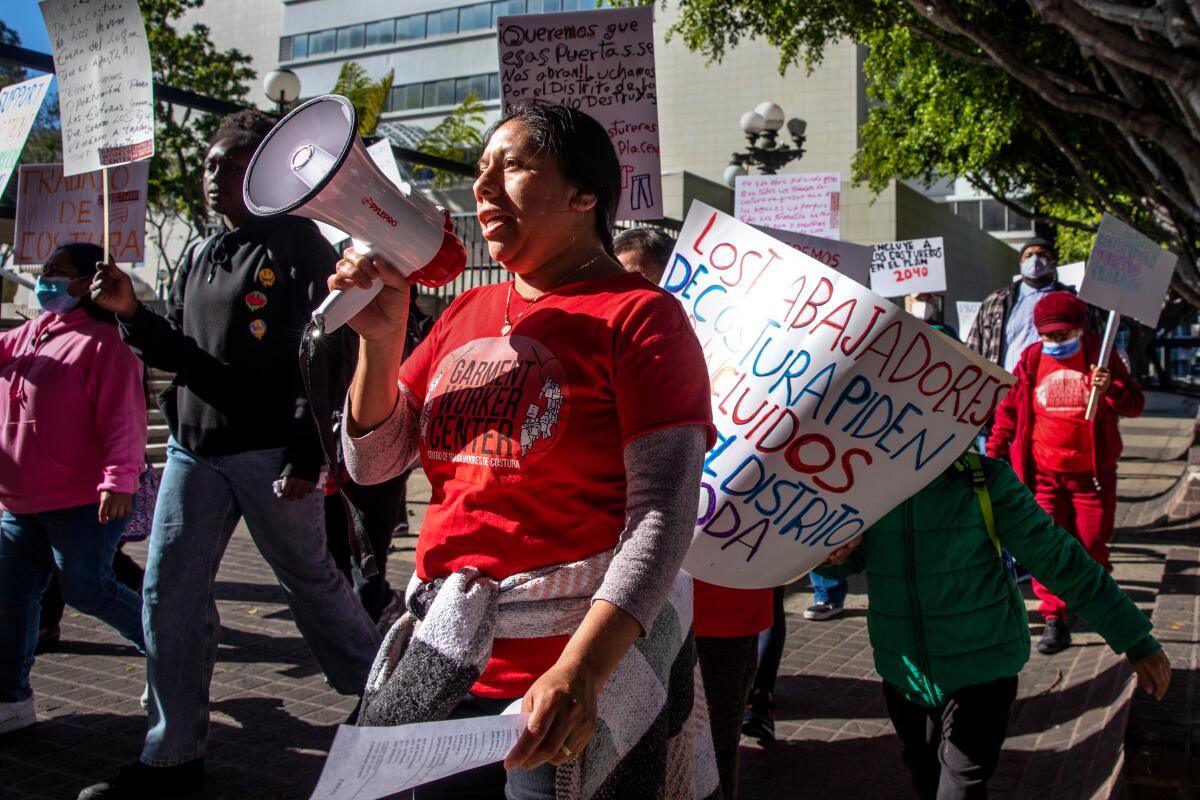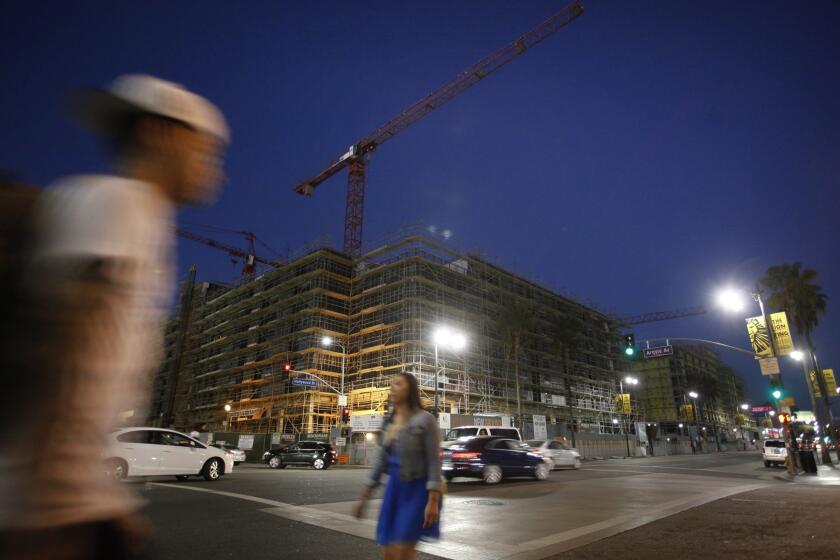L.A. leaders want to save downtown garment jobs. But that could mean fewer new homes

- Share via
Two years ago, policymakers at Los Angeles City Hall came up with a plan to dramatically increase the number of new homes that could be built in downtown L.A., part of their larger strategy for addressing the region’s rapidly rising housing costs.
The city’s planning department released DTLA 2040, a 20-year road map for growth that, if approved by the City Council, would increase downtown’s housing supply by up to 100,000 units. That’s enough to satisfy one-fifth of the need citywide, planners say.
But a key element of that plan has drawn fierce opposition from some of downtown’s lowest-wage workers, who fear that new condominiums and apartment towers will push out garment businesses. Those workers, and their allies in organized labor, succeeded last week in adding new language to the plan in the hope of securing “no net loss” of sewing factories and other fashion-related businesses.
Organizers with the downtown-based Garment Worker Center say those last-minute changes will protect thousands of jobs, in an industry fueled by working-class Mexican and Guatemalan immigrants.
Business leaders, on the other hand, warn the new restrictions would render as many as 12,000 residential units in the DTLA 2040 plan financially infeasible, at least for the immediate future, undercutting efforts to expand the housing supply and make headway on the region’s affordability crisis.
“Each one of those 12,000 units matters,” said Nella McOsker, chief executive of the Central City Assn., a downtown-based business group. “If we begin chipping away at [the plan] piece by piece, with these last-minute decisions that undermine the larger goals of the plan, we reduce downtown’s ability to alleviate this crisis.”
California’s downtowns have had varying levels of success in rebounding from pandemic shutdowns — while San Diego has almost fully recovered, San Francisco is concerned about a potential ‘doom loop.’
Daisy Gonzalez, campaign director at the Garment Worker Center, said L.A.’s fashion sector has been neglected for too long and deserves the type of care and attention that policymakers have devoted to the entertainment industry. Gonzalez, whose group seeks to safeguard the wages and working conditions of apparel workers, resisted the notion of housing and jobs as an either-or proposition.
When it comes to downtown, Gonzalez said, keeping workers in their homes means keeping them employed.
“Garment workers are really in need of their jobs in order to pay for housing. The two things are interconnected. We’re not trying to pit the two things against each other,” she said.
That back-and-forth reflects the city’s larger ongoing debate over how to build more housing without also triggering serious displacement. And it has focused attention on a sector of the economy overshadowed by the entertainment industry.
The City Council is scheduled to vote on the DTLA 2040 plan on Wednesday, along with a second, major growth strategy: the long-delayed update to the Hollywood Community Plan, which was blocked by a judge in 2013 and later rewritten.
Those two documents will set out the rules for developing new homes, offices, sound stages and other projects in Hollywood and downtown. Both plans have new provisions aimed at reducing displacement, boosting the production of affordable housing and extending the life of those affordable projects.
The downtown plan stretches from the Convention Center east to the Arts District and north to Chinatown. However, much of the debate in recent days has focused on the Fashion District, home to an estimated 20,000 garment jobs. The most contested terrain is a slice of the Fashion District bounded roughly by 7th Street on the north, 17th Street on the south, Crocker Street on the east and Santee Street on the west — an area city planners now call the IX3 zone.
The DTLA 2040 plan would prohibit industrial buildings in the IX3 zone from being converted into lofts or hotels. However, developers would be permitted to construct mixed-use development — buildings that have both apartments and space for “productive” uses, such as sewing factories or other types of light manufacturing.
Until recently, the proposal called for developers in the IX3 zone to provide 5,000 square feet of productive space for every 10,000 square feet of land. But last week, the Garment Worker Center — working closely with Unite Here Local 11, the politically powerful hotel workers union — persuaded a City Council committee to rewrite that provision, doubling the amount of required manufacturing space.
Those groups argued that such changes would help protect communities from “luxury commercial development.”
“Hospitality and garment workers need more affordable housing, not more development that could threaten where we live or we work,” said Juan Muñoz-Guevara, a researcher with Unite Here Local 11, at a rally last week.
Hours later, the council’s Planning and Land Use Management Committee voted to double the amount of manufacturing space required in new residential projects proposed in the IX3 section of the Fashion District. The five-member panel also endorsed a provision requiring that new development projects in that area include freight elevators, loading docks and loading bays — the kind that can accommodate heavy machinery and large rolls of fabric.

Councilmember Curren Price requested the increase in required manufacturing space. Councilmember Kevin de León pushed for the inclusion of the freight elevator requirement, saying in a letter that it would “ensure efficient business operations” for garment manufacturers.
Those two changes, if approved by the council, would make about 12,000 of the planned housing units in the DTLA 2040 plan financially “infeasible” — at least for the near future, according to the city’s planning staff. Although market conditions for residential development could eventually change, the expanded elevator and manufacturing space requirements would prevent builders from achieving a “reasonable profit,” they said.
McOsker, the executive at the Central City Assn., said as many as 2,000 of the 12,000 units sought by the city in the IX3 zone would have been designated as affordable. She also argued that the DTLA 2040 plan already had safeguards to protect garment jobs, striking a balance between housing and industry.
A judge has dealt a major blow to Los Angeles’ efforts to spur larger development in parts of Hollywood, calling a new zoning plan for the area “fatally flawed” and saying that the document should be repealed.
“We don’t have any evidence that changing the [plan] saves jobs,” McOsker said. “We do know, and strongly believe, it will kill housing projects before they even begin.”
Anthony Rodriguez, executive director of the L.A. Fashion District Business Improvement District, also spoke against the changes to the downtown plan, saying they will risk the loss of residential units amid a citywide housing crisis. Manufacturing and warehouse space in the IX3 zone already has an 18% vacancy rate, which shows a lack of demand for new garment-related businesses in downtown, he said.
Price spokesperson Angelina Valencia-Dumarot said Tuesday that her boss learned only this week that some of the late changes to the DTLA 2040 plan could result in a reduction in new housing. The council member intends to seek a report on the issue while the city attorney’s office conducts its legal review of the downtown zoning plan, Valencia-Dumarot said.
“Fact is, we have anywhere between six months to a year before the plan is finalized,” she said in an email. “There is still plenty of room for the conversation to evolve.”
Gonzalez, the campaigns director for the Garment Worker Center, said she already views the downtown plan as a compromise, since council members did not agree to all of the changes requested by her group.
“We understand that housing production is extremely important,” she said. “But so are jobs. So we need to really strike a balance.”
More to Read
Sign up for Essential California
The most important California stories and recommendations in your inbox every morning.
You may occasionally receive promotional content from the Los Angeles Times.
















